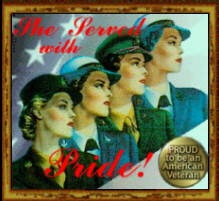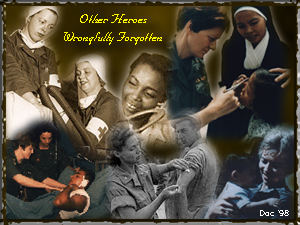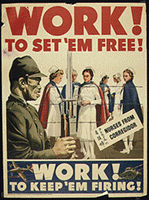Women in the Military

I am woman, hear me roar, in numbers too big to ignore. And I know too much to go back and pretend. 'Cause I've heard it all before, and I've been down there on the floor, no one's ever gonna keep me down again. You can bend but never break me, 'cause it only serves to make me, more determined to achieve my final goal. And I come back even stronger, not a novice any longer, 'cause you've deepened the conviction in my soul. I am woman, watch me grow, see me standing toe to toe, as I spread my lovin' arms across the land. But I'm still an embryo, with a long, long way to go, until I make my brother understand. Oh, yes, I am wise, but it's wisdom born of pain. Yes, I've paid the price, but look how much I gained, if I have to, I can do anything, I am strong, I am invincible, I am woman. Words and song by Helen Reddy and Ray Burton.
Roughly two million women have served in the U.S. military, with thousands more serving within other military forces in other foreign nations. During World War II, more than 150,000 women served in the WAC (Women's Army Corps) in noncombat situations. Thousands of men were relieved of their clerical assignments and released for combat. Prior to 1941, women, (with the exception of nurses), never served in the U.S. Army. It was in May of that year that a Massachusetts Congresswoman named Edith Nourse Rogers introduced a bill that would incorporate women into the army. She thought that women might actually be needed, and she was praying that her actions would initiate a role that brought in a paycheck and benefits equal to that of the male soldiers.
At first the public was not very keen to her idea. They almost thought it to be insane. The law was left hanging in the balance until the bombing of Pearl Harbor. After that it became law and activated on May 15, 1942 ~ exactly one year and one day after it was introduced. This bill established the Women's Auxiliary Army Corps (WAAC) and gave these women an official status with a salary, but very few benefits. After thousands of women enlisted, the summer of '43 watched as the army dropped the "auxiliary" part of the name, and finally gave women full army benefits. WACs served as a separate part of the army for the remainder of WWII, the Korean War, and Vietnam War before being totally integrated into the ranks of the U.S. Army in 1978.

Through the years, people were slow to reconize and give credit to the women who gave the ultimate sacrifice. During the Civil War, many deaths were recorded. In 1863, a young lady named Emily ran away from home and joined the drum corps. This regiment was sent to Tennessee and during the struggle she was struck in the side with a minie ball. Her gender was revealed when she layed there dying. Two women in Confederate clothing were found after the Battle of Gettysburg, and a Union flag bearer (also was a woman) was killed near Picketts Charge. During WWII, more than 400 women lost their lives while serving their country. During an attack of a tented hospital in Anzio, six Army nurses were killed by German bombs. Four nurses that survived received the Silver Star for courage under fire. Four other nurses were wounded as well when their ship the "USS Comfort" was hit by a Kamakazi plane. The Korean War brought more women and more death to our unsung heroes. Many were from the Navy Nurse Corps. How exactly they died I do not know. However, they're significant and important to us as a nation. During the Vietnam War, thousands perished. These numbers come from many venues. These women were from the military, some were civilian, others were journalists, missionaries, or part of the operation to transport Vietnamese children out of Saigon in 1975. All were important in their own right. It was during Desert Storm that we saw our first female casualities in combat roles. Many were helicopter pilots or drivers. No matter how great or small, these women paid the ultimate sacrifice and should be honored and remembered proudly as American heroes. May their voices never leave our lips.

When someone says to you "Support the efforts to bring home the MIA's and POW's", do you think of men? Most people would. However, there were women POW's too. I don't believe that anyone had it in their head that they would ever become one, or actually have to use what they were taught. These women did though, and they should be reconized.
Mildred Harnack-Fish ~ 1943 Berlin's Plotzense Prison, interned and killed.
Lt. Reba Whittle ~ Army flight nurse, hospital plane shot down 1944.
Agnes Newton Keith ~ Japanese camps from 1941 to the end of the war
Monika Shwinn ~ German nurse, three and a half years at the Hanoi Hilton
Evelyn Anderson ~ missionary, captured and burned to death in Kengkok, Laos 1972
Beatrice Kosin ~ same fate as Evelyn Anderson
Betty Ann Olsen ~ Ban McThout during the Tet Offensive 1968, died & buried along Ho Chi Minh Trail
Eleanor Ardel Vietti ~ Ban Me Thout May 30, 1962~ Still listed as a POW
Major Rhonda Cornum ~ Army flight surgeon, Gulf War
Sp. Melissa Rathbun-Nealy ~ Army transportation specialist, Gulf War
There were also women who received medals for their efforts. The following women were the first to receive these honors.
Dr. Mary E. Walker ~ Medal of Honor- Cival War
Ann Leah Fox ~ Purple Heart- Pearl Harbor
Lt. Cordelia E. Cook ~ Bronze Star- WWII in Italy
Lt. Edith Greenwood ~ The Soldiers Medal- 1943
Barbara Olive Barnwell ~ Navy/Marine Corps Medal for heroism in 1953
Lt. Elsie S. Lott ~ Air Medal- 1943
Colonel Oveta Culp Hobby ~ US Army Distinguished Service Medal-1945
This page serves as a history and lineage for the women in the armed forces. These women were Americans, doing what our country asked of them, no more and no less. As a vetern, I know the pride, the satisfaction, the pain and the constant need to "prove one's self" in a place where you are required to give 110% reguardless. We are, and have always been, up to the challenge. To all the women in the military, I salute you and say "Well done soldier!"


